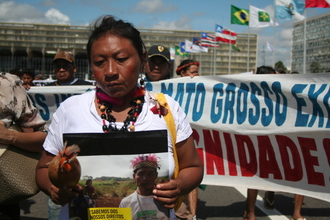Kaiowá Guarani indigenous group retake traditional lands
 The Kaiowá Guarani indigenous group retook part of their traditional lands last Friday (13). They occupied a small section of the Laranjeira Nhanderu area in Rio Brilhante (Mato Grosso do Sul), from where they have been expelled for almost two years
The Kaiowá Guarani indigenous group retook part of their traditional lands last Friday (13). They occupied a small section of the Laranjeira Nhanderu area in Rio Brilhante (Mato Grosso do Sul), from where they have been expelled for almost two years
The occupation takes place just days after more than 100 members of the Xavante indigenous group retook part of the Suiá-Missú estate, in Alto da Boa Vista, Mato Grosso, at the beginning of last week. The estate is located within the Marãiwatsede indigenous land from where the Xavante have been expelled for over 40 years.
As well as demanding the right to access their traditional lands, both groups have called for a swift conclusion to the land demarcation process and for the ousting of the intruders there.
Kaiowá Guarani
The first attempt to retake the Laranjeira Nhanderu area took place in May 2008. For over a year, members of the group were able to stand their ground in the face of several attempts by the landlord of the Santa Antônio de Boa Esperança estate to evict them. They stayed put until September 2009, when the court ordered that the area, located in traditional land, be immediately repossessed.
The Kaiowá Guarani were evicted from the estate and set up camp nearby, along the edge of the BR-163 highway. They have since remained there for over a year and eight months. “Along with a number of other Guarani communities living along the edges of the state highways, be they in Mato Grosso do Sul or in Rio Grande do Sul, the indigenous people have suffered all sorts of rights violations throughout this time. Food and drinkable water have been denied to them”, reads a statement from the Indigenous Missionary Council (CIMI).
The Kaiowá Guarani have been claiming the Laranjeira Nhanderu area as theirs for decades. The area is included in the Working Groups (Grupos de Trabalho, GTs) for the purpose of demarcation by the federal government. The area still has not been demarcated however.
In a Conduct Adjustment Term (TAC) signed in 2007 between indigenous leaders, the Federal Public Ministry of Mato Grosso do Sul and the National Indian Foundation (FUNAI), FUNAI was given the task of promoting the identification of 36 traditional lands claimed by the Kaiowá Guarani to be their own, among which was the Laranjeira Nhanderu area. According to the CIMI however, the TAC was not complied with. “To this day, no traditional land claimed by the Kaiowá Guarani in areas covered by the TAC has been identified”, read a statement.
Xavantes
In the São Feliz do Araguaia region of Mato Grosso state, the Xavantes have been fighting for the Marãiwatsede land for over 40 years. They were expelled in the 1960s from the area, which fell into the possession of the Suiá-Missú agricultor. In 1990 the traditional territory was returned to them, but was illegally invaded by colonizers before it could be regularized.
Since 1998, the area in which the Suiá-Missú estate is located has been recognized as traditionally Xavante territory, and even the President of the Republic has recognized it as such.
In November 2010, the Federal Regional Tribunal of the 1st Region (TRF-1) declared all non-indigenous occupiers to be acting with malice and doing so on Union property. However, the colonizers have remained in the area to this day.
Gilberto Vieira dos Santos of the Mato Grosso CIMI explains that the indigenous group began the process of retaking their traditional land in 2004 because of the long delay in effecting the removal of the colonizers. “The Xavantes became tired of waiting and began retaking their land. It is demarcated land, recognized as theirs. And there is a court order demanding the removal of its occupants. But until now, this has failed to materialize”, he explains.
According to him, the indigenous group found that the estate was encroaching on the forest and increasing deforestation in the region. “The invaders, knowing that they will eventually have to leave the land, will take every opportunity to sack whatever they can from the area”, Santos continues.
Last Thursday (12), the Federal Public Ministry (MPF) filed a request to the federal court demanding that all non-indigenous occupants of the Marãiwatsede land vacate the area.
Santos explains that besides this, the indigenous group and the CIMI have requested the presence of the Federal Police and members of the National Institute of Colonization and Agrarian Reform (INCRA) to oversee the removal of non-indigenous people and the resettlement of any who have nowhere to go. There has still been no response as of Monday 16th May.
